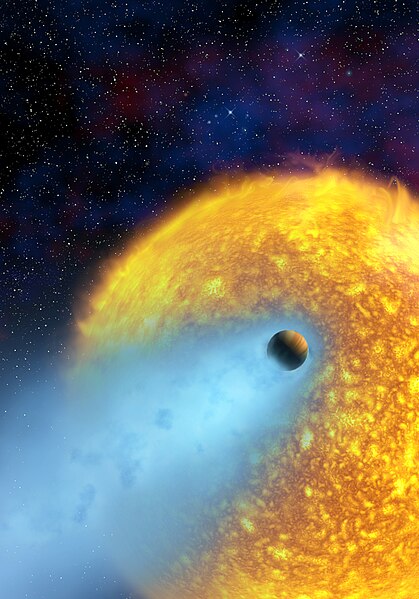
(Image Credit: NASA)
Picture a world where the year is 5 earth-days long, and the sun never rises or sets, but remains fixed directly overhead. The cloud tops on the sunlit side of the planet are thousands of degrees, and are made of vaporized minerals and metals. Iron smog and wisps of quartz are shunted from the scorching daylit side to the perpetually dark night side, which glows a dull red, pouring its excess heat into space. The upper hydrogen atmosphere is continually ripped from the planet and streams out into space like the tail of a comet.
Although it sounds like it belongs in the realm of science fiction, this description may actually be quite accurate for many of the planets that astronomers have found around other stars. The most successful method for detecting planets, called the "radial velocity" method, relies on detecting the small motions of stars as their planets orbit and tug them back and forth. Just as the siren on an ambulance is higher pitched when it is approaching than when it is receding, the light from a star looks slightly bluer when the star is moving toward us and slightly redder when it is moving away. Since the size of the shift depends upon the mass of the planet and how rapidly it orbits, many of the exoplanets discovered are larger than Jupiter, and orbit their star in a matter of days.
The first "hot jupiters" were a shock to the scientific community because it is thought that gas giants have to form very rapidly, before their star becomes hot enough to blow all of the primordial gas out of the system. To form so rapidly, most formation theories require the giant planets to form far enough out in the solar system for ices to be present. Too close to the sun and the only things that can clump together to form the seed for a giant planet are rocks. Farther out, beyond the so-called "snow line", ice can also clump together with the rocks, allowing the cores of giant planets to form rapidly and accumulate gas before it gets blown away.
Because ice appears to be required to form giant planets, how can they possibly form so close to their stars? The answer is: they don't! The latest research suggests that in the early days of a solar system, the planets move around quite a bit. Often, big planets toss small things like comets, asteroids, and protoplanets out of the solar system. As they fly off into interstellar space, these small pieces of debris take energy and angular momentum from the giant planet with them. The result is that giant planets tend to drift inward as they fling things outward. At the same time, if there is still gas in the system, the planet will also interact with that gas, creating waves. These waves also steal the planet's angular momentum and send it spiraling inward. In this way, a giant planet could conceivably form in the icy outer reaches of the solar system and then bully its way inward, scattering debris and making waves as it does so.
The story of hot Jupiters is a great example of science in action: giant planets were discovered a lot closer to their stars than they had any right to be, based on our understanding of planet formation. Far from weakening the theory however, the discovery of "hot jupiters" let scientists to figure out that planet migration is a very important process in the formation of a solar system. The theory emerged stronger than ever, able to explain a wider variety of potential solar systems.
So, next time you step outside, take a look at the rocks on the ground and think about a world so hot that those rocks vaporize and form clouds. And then, while you're marveling at that idea, remember that worlds like that really do exist!
"The Universe is not only queerer than we suppose, but queerer than we can suppose." - J.B.S. Haldane
Image credit: European Space Agency, Alfred Vidal-Madjar (Institut d'Astrophysique de Paris, CNRS, France) and NASA.
Sunday, December 16, 2007
Hot Jupiters
Subscribe to:
Post Comments (Atom)



No comments:
Post a Comment